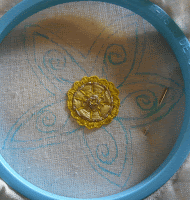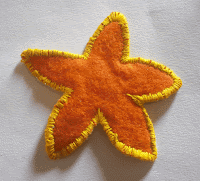 This sampler is made in the shape of an egg to resemble a decorated Easter egg. This is a simple classic pattern that is a great way to learn and practice new stitches. The egg is about 2 and half by 3 and half inches. I outlined the egg shape with the stem stitch first. Then I started in the center with a medium border stitch. I used the Guilloche Stitch which is a combination stitch. Either side is outlined with the stem stitch. Between them rows of straight stitches are evenly spaced. Threads are laced under the straight stitches making a looped edge on either side. Last a French knot is placed between the rows of straight stitches in the center.
This sampler is made in the shape of an egg to resemble a decorated Easter egg. This is a simple classic pattern that is a great way to learn and practice new stitches. The egg is about 2 and half by 3 and half inches. I outlined the egg shape with the stem stitch first. Then I started in the center with a medium border stitch. I used the Guilloche Stitch which is a combination stitch. Either side is outlined with the stem stitch. Between them rows of straight stitches are evenly spaced. Threads are laced under the straight stitches making a looped edge on either side. Last a French knot is placed between the rows of straight stitches in the center.
 The next rows are made one above and the same row below. This way the top and the bottom of the egg will look the same. The second row is an isolated stitch the reverse fly stitch. It is made by putting one fly stitches facing towards the center then another on top facing the outer edge. It is important to make each stitch the same and mark them out so they will be evenly spaced.
The next rows are made one above and the same row below. This way the top and the bottom of the egg will look the same. The second row is an isolated stitch the reverse fly stitch. It is made by putting one fly stitches facing towards the center then another on top facing the outer edge. It is important to make each stitch the same and mark them out so they will be evenly spaced. The third row is a line stitch called the feathered chain stitch. It is made of long tail chain stitches leaning towards each other in a zigzag pattern. I tried the first line without marking it out but it looks much better when the stitches were measured out first.
The third row is a line stitch called the feathered chain stitch. It is made of long tail chain stitches leaning towards each other in a zigzag pattern. I tried the first line without marking it out but it looks much better when the stitches were measured out first.The fourth row is an isolated stitch the cross and twist stitch. It starts with a cross stitch with a knotted stitch on top.
There was plenty of room on the bottom for another row but I was running out of room on top. So I used a row of small simple French knot stitches for the final row. This one is all in purple I would like to try a few more in a combination of light Easter colors.


















